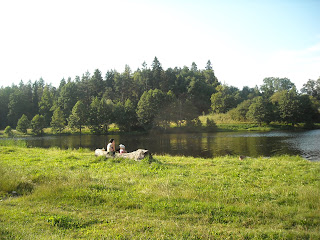
A nearby pond where Sylvia's father and family probably went swimming.

The government supplied fences made out of concrete.

In Sunchek.

A building in the Minsk center.

It is Saturday afternoon about 3:30, I’m sitting here in the sweltering heat—just checked the internet and it is 39 degrees Celsius, which is about 103. I have my windows shut up against the afternoon heat, but I feel trapped and really want to go for a walk, trying to get myself to wait until a little later. My recently acquired fan (thanks to Neshet and Lenura) has gone over to the neighbors for their big family gathering this weekend. But I just put a wet rag around my neck—that helps. The Crimean Tatars say that this weather is what Uzbekistan was like.
But I really want to write about Belarus, before I get too far away from the experience. Belarus is a country that I never thought I would visit. Even living in this part of the world, it is not a place people travel to, even locals unless they have family there. There are very few “tourist destinations” in Belarus, and the government doesn’t exactly promote tourism, as far as I can tell. They certainly don’t make it easy to get visas, as I said in my last blog. But in spite of all of this, I found the little part of Belarus where we stayed for a week very beautiful, the people friendly, and with a rich, but tragic, history. Like Ukraine, Belarus is a region that is a borderland between two bigger countries, and its destiny over the centuries has been dictated by its ever changing occupation by Poland or Russia. At the beginning of World War II, Belarus was first part of Poland, then occupied by Germany, and at the end of the war, it became part of the Soviet Union. Though today it is an independent country, it is the former Soviet Bloc country that has remained closest to the Soviet model, with a near dictator for a president, limited freedom of speech, and continuing government ownership of some industry and collectivized farms. But as a result of such a government, it has at least outwardly, a much more neat, organized, and prosperous look than does Ukraine. It is very clean and kept up looking. The frequent litter and piles of trash and crumbling infrastructure that I have come to accept in Ukraine, were noticeably absent in Belarus. Minsk, the capital city, was particularly neat and orderly looking, in part due to the fact that it was pretty much leveled during the war and rebuilt with the utilitarian looking Soviet architecture. But even the countryside had that look about it, and the town of Navagrudak where we spent our week, had picturesque fences lining the major thoroughfares, fences which we found out later were supplied by the government to present a “nice appearance,” ignoring, as our Belarus host said, what was on the other side of the fences. We were located in the central part of Belarus, and the land reminded me so much of Minnesota—rolling farm land of wheat and barley fields, frequent forests of birch and fir trees, marsh lands, clear cold lakes and rivers. It was quite beautiful in a way I did not expect. Not a dramatic beauty, but that beauty you find in the American Midwest and which has been a constant throughout my life.
But the history of Belarus, and why we had ventured there, couldn’t have been more different from my land of origin. My friend Sylvia’s mother and father were from Belarus. Her mother was from the town of Baranovichi, and when she married, she moved to Navagrudak. Sylvia’s father was from Sunchek, a small farming hamlet outside of Navagrudak, a town of about 10,000 and 64% Jewish at the time of World War II. Both of her parents were married at the time of the war and had children. All of their families perished in the Holocaust—Sylvia’s mother’s sisters, brother, parents, husband, and 18-month-old child. Sylvia’s father’s wife and four children and other relatives were also killed, though he managed to rescue three young nieces who are alive today and living in the U.S. and Israel. Both her parents hid out in the forests and near the end of the war became part of the Jewish Partisans known as the Bielski Partisans whose story was recently depicted in the film, Defiance. They met in the partisan group and then married at the end of the war and immigrated to the U.S. So armed with what little knowledge she could gleam from her cousins’ memories, her own memories of her parents stories (her parents are no longer alive)and recent visits of other Holocaust survivors, Sylvia came to Belarus to find out what she could about the homeland of her family.
No comments:
Post a Comment